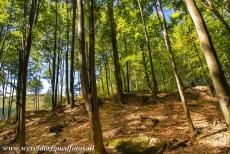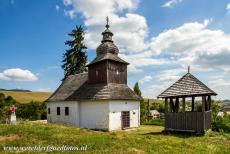Primeval Beech Forests of the Carpathians and other regions in Europe: The primeval beech forests are the last remaining parts of a large beech forest, that once covered a large part of Europe. The ancient forests are indispensable to understanding the history and evolution of the common beech, the Fagus sylvatica. The primeval beech forests also holds the largest, tallest and oldest beeches of the species Fagus sylvatica in the world. The primeval beech forests are home to a diverse flora and fauna. The primeval beech forests in Slovakia are situated in four protected areas: Havešová, Stuzica, Rozok and Vihorlat. The primeval beech forests of Slovakia and Ukraine were declared a UNESCO World Heritage in 2007, the Ancient Beech Forests of Germany were a completion of the UNESCO World Heritage and were inscribed in 2011, several new locations were inscribed in 2017 and in 2021. Now, the transboundary site stretches over 18 European countries and was inscribed on the UNESCO World Heritage List as: Ancient and Primeval Beech Forests of the Carpathian and other regions in Europe. It is a natural UNESCO World Heritage Site. World Heritage Art: Ancient Beech Forest and Primeval Beech Forest
www.werelderfgoedfotos.nl © Copyright World Heritage Photos

Primeval Beech Forests of the Carpathians and other regions in Europe: The wooden church of Hrabová Roztoka in Slovakia is dedicated to St. Basil the Great. The 18th century Greek Catholic church lies on a hill high above the tiny village of Hrabová Roztoka. Several components of the primeval beech forests of the Carpathians are situated close to the village and wooden church of Hrabová Roztoka. Hrabová Roztoka is situated in the Snina District, just a few kilometres from the border with Ukraine. The village has about 68 inhabitants.

Primeval Beech Forests of the Carpathians and other regions in Europe: The wooden church of Hrabová Roztoka in Slovakia is dedicated to St. Basil the Great. The 18th century Greek Catholic church lies on a hill high above the tiny village of Hrabová Roztoka. Several components of the primeval beech forests of the Carpathians are situated close to the village and wooden church of Hrabová Roztoka. Hrabová Roztoka is situated in the Snina District, just a few kilometres from the border with Ukraine. The village has about 68 inhabitants.

The primeval beech forests of the Carpathians, the ancient beech forests of Germany and other regions in Europe are the last remaining parts of an immense beech forest, that once covered a large part of Europe. The primeval beech forests are essential to understanding the history and evolution of the common beech, Fagus sylvatica. The European beech forests contain the tallest, largest and oldest common beeches in the world. The primeval beech forests of the Carpathians and other regions in Europe were declared a UNESCO World Heritage.

In front of the wooden church of Topola, or Topol'a, lies a WWI military cemetery. The church of the village of Topola was built in the 17th century. Topola has about 185 inhabitants, the village is situated in the Snina District in Slovakia, the Snina District borders with Ukraine in the east. Topola is situated in the Havešová Primeval Forest and one of the starting points for hiking trails in the Havešová Primeval Forest, a part of Poloniny National Park. Havešová is part of the World Heritage: Primeval Beech Forests of the Carpathians and other regions in Europe.

The ancient and primeval beech forests of the Carpathians and other regions in Europe are the last remaining parts of an immense beech forest, that once covered a large part of Europe. The primeval beech forests of Slovakia and Ukraine became a UNESCO World Heritage Site in 2007. The ancient beech forests of Germany were added to the site in 2011, several other locations were added in 2017, the site now stretches over 12 countries and was inscribed on the UNESCO World Heritage List as: Primeval Beech Forests of the Carpathians and other regions in Europe.

Primeval beech forests of the Carpathians and other regions in Europe: The tiny Greek Catholic wooden church of St. John the Baptist in Kalná Roztoka was built in 1750, the church has white-washed clay plaster on its exterior walls. The village of Kalná Roztoka is situated near the border of Poloniny National Park in Slovakia, the primeval beech forests of Havešová, Stužica and Rožok are situated in Poloniny National Park, the Slovak primeval beech forest of Vihorlat are situated in the Vihorlat Protected Landscape Area in Slovakia.

Primeval Beech Forests of the Carpathians and other regions in Europe: The Vihorlat Mountain area is of volcanic origin, the middle section of the mountain range is protected by the Vihorlat Protected Landscape Area and contains a part of the primeval beech forests of the Carpathians. The largest lake in the area is the Morské Oko. The Vihorlat Protected Landscape Area is located in the Humenné, the Sobrance and Snina districts. The Primeval Beech Forests of Slovakia are situated in four protected areas, all in eastern Slovakia: Havešová, Stužica, Rožok and Vihorlat.

Primeval Beech Forests of the Carpathians and other regions in Europe: The wooden church of the village of Ruský Potok was built in 1740, the Ruthenian Greek Catholic Church is dedicated to Archangel Michael. Ruský Potok is located at an altitude of 440 metres and is surrounded by the primeval beech forests of the Slovak Carpathians. Almost every village in the Carpathians has its own wooden church. The wooden churches of the Carpathians are masterpieces of arts, crafts and woodcutting.

The Primeval Beech Forests of the Carpathians and other regions in Europe: The new Ruthenian Greek Catholic Church of Ruský Potok, the village of Ruský Potok is situated in Poloniny National Park. Ruský Potok is surrounded by the forested hills of Poloniny National Park and the primeval beech forests of the Carpathians. Three parts of the primeval beech forests of the Carpathians are preserved in Poloniny National Park: Havešová, Stužica and Rožok. The other protected area is Vihorlat, situated in the Humenné, the Sobrance and Snina districts.
